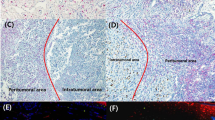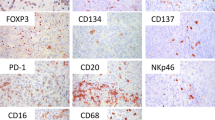Abstract
Adaptive immune responses contribute to the pathogenesis of melanoma by facilitating immune evasion. V-domain Ig suppressor of T-cell activation (VISTA) is a potent negative regulator of T-cell function and is expressed at high levels on monocytes, granulocytes, and macrophages, and at lower densities on T-cell populations within the tumor microenvironment. In this study, 85 primary melanoma specimens were selected from pathology tissue archives and immunohistochemically stained for CD3, PD-1, PD-L1, and VISTA. Pearson’s correlation coefficients identified associations in expression between VISTA and myeloid infiltrate (r = 0.28, p = 0.009) and the density of PD-1+ inflammatory cells (r = 0.31, p = 0.005). The presence of VISTA was associated with a significantly worse disease-specific survival in univariate analysis (hazard ratio = 3.57, p = 0.005) and multivariate analysis (hazard ratio = 3.02, p = 0.02). Our findings show that VISTA expression is an independent negative prognostic factor in primary cutaneous melanoma and suggests its potential as an adjuvant immunotherapeutic intervention in the future.


Similar content being viewed by others
Abbreviations
- AJCC:
-
American Joint Committee on Cancer
- CI:
-
Confidence interval
- HR:
-
Hazard ratio
- TCGA:
-
The cancer genome atlas
- TIIC:
-
Tumor-infiltrating inflammatory cells
References
Garbe C, Eigentler TK, Keilholz U, Hauschild A, Kirkwood JM (2011) Systematic review of medical treatment in melanoma: current status and future prospects. Oncologist 16(1):5–24
Geller AC, Zhang Z, Sober AJ, Halpern AC, Weinstock MA, Miller DR et al (2003) The first 15 years of the American Academy of Dermatology skin cancer screening programs: 1985–1999. J Am Acad Dermatol 48(1):34–41
Jemal A, Saraiya M, Patel P, Cherala SS, Barnholtz-Sloan J, Kim J et al (2011) Recent trends in the cutaneous melanoma incidence and death rates in the United States, 1992–2006. J Am Acad Dermatol 65(5 Suppl 1):S17–S25 (e1–3)
Balch CM, Soong SJ, Gershenwald JE, Thompson JF, Reintgen DS, Cascinelli N et al (2001) Prognostic factors analysis of 17,600 melanoma patients: validation of the American Joint Committee on Cancer melanoma staging system. J Clin Oncol 19(16):3622–3634
Clemente CG, Mihm MC Jr, Bufalino R, Zurrida S, Collini P, Cascinelli N (1996) Prognostic value of tumor infiltrating lymphocytes in the vertical growth phase of primary cutaneous melanoma. Cancer 77(7):1303–1310
Clark WH Jr, From L, Bernardino EA et al (1969) The histogenesis and biologic behavior of primary human malignant melanomas of the skin. Cancer Res 29(3):705–727
Azimi F, Scolyer RA, Rumcheva P, Moncrieff M, Murali R, McCarthy SW et al (2012) Tumor-infiltrating lymphocyte grade is an independent predictor of sential lymph node status and survival in patients with cutaneous melanoma. J Clin Oncol 30(21):2678–2683
Taube JM, Anders RA, Young GD, Xu H, Sharma R, McMiller TL et al (2012) Colocalization of inflammatory response with B7-h1 expression in human melanocytic lesions supports an adaptive resistance mechanism of immune escape. Sci Transl Med 4(127):127ra37
Freeman GJ, Long AJ, Iwai Y, Bourque K, Chernova T, Nishimura H et al (2000) Engagement of PD-1 immunoinhibitory receptor by a novel B7 family member leads to negative regulation of lymphocyte activation. J Exp Med 192(7):1027–1034
Wang L, Rubinstein R, Lines JL, Wasiuk A, Ahonen C, Guo Y et al (2011) VISTA, a novel mouse Ig superfamily ligand that negatively regulates T cell responses. J Exp Med 208(3):577–592
Lines JL, Pantazi E, Mak J, Sempere LF, Wang L, O’Connell S et al (2014) VISTA is an immune checkpoint molecule for human T cells. Cancer Res 74(7):1924–1932
Flies DB, Wang S, Xu H, Chen L (2011) Cutting edge: a monoclonal antibody specific for programmed death-1 homolog prevents graft-versus-host disease in mouse models. J Immunol 187(4):1537–1541
Lines JL, Sempere LF, Broughton T, Wang L, Noelle R (2014) VISTA is a novel broad-spectrum negative checkpoint regulator for cancer immunotherapy. Cancer Immunol Res 2(6):510–517
Le Mercier I, Chen W, Lines JL, Day M, Li J, Sergent P et al (2014) VISTA regulates the development of protective antitumor immunity. Cancer Res 74(7):1933–1944
Piras F, Colombari R, Minerba L, Murtas D, Floris C, Maxia C et al (2005) The predictive value of CD8, CD4, CD68, and human leukocyte antigen-D-related cells in the prognosis of cutaneous malignant melanoma with vertical growth phase. Cancer 104(6):1246–1254
The Cancer Genome Atlas Network (2015) Genomic classification of cutaneous melanoma. Cell 161(7):1681–1696
Wu L, Deng WW, Huang CF, Bu LL, Yu GT, Lao L et al (2017) Expression of VISTA correlated with immunosuppression and synergized with CD8 to predict survival in human oral squamous cell carcinoma. Cancer Immunol Immunother 66(5):627–636
Weber J, Mandala M, Del Vecchio M, Gogas HJ, Arance AM, Cowey CL et al (2017) Adjuvant nivolumab versus ipilimumab in resected stage III and IV melanoma. N Engl J Med 377(19):1824–1835
Eggermont AM, Chiarion-Sileni V, Grob JJ, Dummer R, Wolchok JD, Schmidt H et al (2016) Prolonged survival in stage III melanoma with ipilimumab adjuvant therapy. N Engl J Med 375(19):1845–1855
Pardoll DM (2012) The blockade of immune checkpoints in cancer immunotherapy. Nat Rev Cancer 12(4):252–264
Topalian SL, Taube JM, Anders RA, Pardoll DM (2016) Mechanism-driven biomarkers to guide immune checkpoint blockade in cancer therapy. Nat Rev Cancer 16(5):275–287
Hino R, Kabashima K, Kato Y, Yagi H, Nakamura M, Honjo T et al (2010) Tumor expression of programmed cell death-1 ligand 1 is a prognostic factor for malignant melanoma. Cancer 116(7):1757–1766
Velcheti V, Schalper KA, Carvajal DE, Anagnostou VK, Syrigos KN, Sznol M et al (2014) Programmed death ligand-1 expression in non-small cell lung cancer. Lab Investig 94(1):107–116
Ahmadzadeh M, Johnson LA, Heemskerk B, Wunderlich JR, Dudley ME, White DE et al (2009) Tumor antigen-specific CD8 T cells infiltrating the tumor express high levels of PD-1 and are functionally impaired. Blood 114(8):1537–1544
Oba J, Nakahara T, Abe T, Hagihara A, Moroi Y, Furue M (2014) Expression of programmed death receptor ligand 1 in melanoma may indicate tumor progression and poor patient survival. J Am Acad Dermatol 70(5):954–956
Tumeh PC, Harview CL, Yearley JH, Shintaku IP, Taylor EJ, Robert L et al (2014) PD-1 blockade induces responses by inhibiting adaptive immune resistance. Nature 515(7528):568–571
Madore J, Vilain RE, Menzies AM, Kakavand H, Wilmott JS, Hyman J et al (2015) PD-L1 expression in melanoma shows marked heterogeneity within and between patients: implications for anti-PD-1/PD-L1 clinical trials. Pigment Cell Melanoma Res 28(3):245–253
Wang Q, He J, Flies DB, Luo L, Chen L (2017) Programmed death one homolog maintains the pool size of regulatory T cells by promoting their differentiation and stability. Sci Rep 7(1):6086
Liu J, Yuan Y, Chen W, Putra J, Suriawinata AA, Schenk AD et al (2015) Immune-checkpoint proteins VISTA and PD-1 nonredundantly regulate murine T-cell responses. Proc Natl Acad Sci USA 112(21):6682–6687
Gadiot J, Hoojikaas AI, Kaiser AD, van Tinteren H, van Boven H, Blank C (2011) Overall survival and PD-L1 expression in metastasized malignant melanoma. Cancer 117(10):2192–2201
Thompson RH, Kuntz SM, Leibovich BC, Dong H, Lohse CM, Webster WS et al (2006) Tumor B7-H1 is associated with poor prognosis in renal cell carcinoma patients with long-term follow-up. Cancer Res 66(7):3381–3385
Tsang JY, Au WL, Lo KY, Ni YB, Hlaing T, Hu J et al (2017) PD-L1 expression and tumor infiltrating PD-1+ lymphocytes associated with outcome in HER2+ breast cancer patients. Breast Cancer Res Treat 162(1):19–30
Danilova L, Wang H, Sunshine J, Kaunitz GJ, Cottrell TR, Xu H et al (2016) Association of PD-1/PD-L axis expression with cytolytic activity, mutational load, and prognosis in melanoma and other solid tumors. Proc Natl Acad Sci USA 113(48):E7769–E7777
Kakavand H, Jacket LA, Menzies AM, Gide TN, Carlino MS, Saw RPM et al (2017) Negative immune checkpoint regulation by VISTA: a mechanism of acquired resistance to anti-PD-1 therapy in metastatic melanoma patients. Mod Pathol 30(12):1666–1676
Funding
This work was supported by National Cancer Institute Grant NCI P30CA023108, Dartmouth Hitchcock Melanoma Funds, and funding provided by Immunext. In addition, Dr. Randolph Noelle has support from NCI RO1 AI098007 and NCI RO1 CA214062, Dr. Mary Jo Turk from NCI RO1 CA214062, and Dr. Marc Ernstoff from NCI PO1 CA206980 and NCI P30 CA016056.
Author information
Authors and Affiliations
Contributions
LFK: interpreted data and wrote the manuscript. SY: conceived the study, interpreted data, and wrote the manuscript. ZL: analyzed data. JLF: interpreted data and wrote the manuscript. CC: analyzed data. RJN: edited the manuscript. CVA: edited the manuscript. MJT: edited the manuscript. MSE: conceived and supervised the study, interpreted data, and wrote the manuscript.
Corresponding author
Ethics declarations
Conflict of interest
Randolph J. Noelle is the co-founder of ImmuNext. All other authors declare no conflicts of interest.
Ethical approval
This study was approved by the Dartmouth College Committee for the Protection of Human Subjects/Institutional Review Board, approval number 23388, and was in compliance with ethical guidelines according to the Declaration of Helsinki.
Informed consent
Informed consent was waived by the Institutional Review Board on the grounds of being a retrospective study using tumor tissue already archived by the Dartmouth-Hitchcock Medical Center Department of Pathology tumor bank. Many patients were deceased. All data was abstracted from the medical record and had previously been obtained for the purposes of medical care.
Rights and permissions
About this article
Cite this article
Kuklinski, L.F., Yan, S., Li, Z. et al. VISTA expression on tumor-infiltrating inflammatory cells in primary cutaneous melanoma correlates with poor disease-specific survival. Cancer Immunol Immunother 67, 1113–1121 (2018). https://doi.org/10.1007/s00262-018-2169-1
Received:
Accepted:
Published:
Issue Date:
DOI: https://doi.org/10.1007/s00262-018-2169-1




